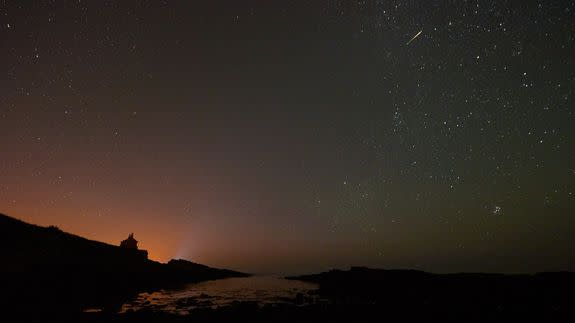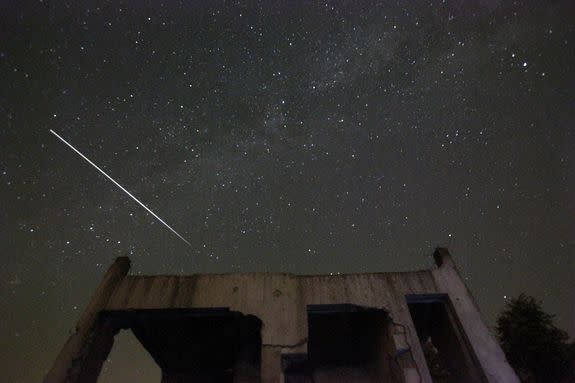Your guide to the potentially awesome Perseid meteor shower this week

One of the best meteor showers of the year will grace skies around the world this week, culminating in a potential "outburst" of shooting stars during the overnight hours between August 11 to August 12.
The Perseid meteor shower is bound to impress people lucky enough to watch the meteor display from very dark skies this year.
SEE ALSO: Next week's Perseid meteor shower could be like no other
Some forecasts are predicting that during its peak, meteor rates could be double the traditional rate expected for this shower that occurs each year around this time. This means there could be as many as 200 shooting stars per hour.
But before you head out to try to spot some shooting stars, there are a few things to keep in mind.
The shower peaks in the early morning on Friday
Your best chance to see the peaking of the Perseids will be to head outside and get somewhere dark by around 3 a.m. local time on August 12.
If predictions hold, skywatchers should get a pretty good view of a high rate of meteors from midnight to around dawn that morning after the moon sets.

Image: AP Photo/Amel Emric
If early morning on Friday won't work, however, you should still be able to see some Perseids shooting through the skies all week, it's just that the best rates should happen on August 12.
“Forecasters are predicting a Perseid outburst this year with double normal rates on the night of Aug. 11-12,” NASA meteor expert Bill Cooke said in a statement. “Under perfect conditions, rates could soar to 200 meteors per hour.”
It should be noted that "perfect conditions" are difficult to achieve for most people in the United States or in populous areas around the world.
The highest rates of meteors will only be visible to people in deep darkness, far from artificial light.
There are, however, ways to increase your odds of seeing meteors even in suburban areas.
Get somewhere that gives you a view of a large piece of the sky
If you're hoping to see some meteors this week, get somewhere that affords you a view of the largest piece of the sky you can find. For example, a park, field or somewhere on the coast with relatively limited light pollution should be ideal.
It also takes about 45 minutes for your eyes to fully adjust to darkness, before you'll likely be able to spot any meteors other than the brightest ones, according to skywatching experts.
"You are going to want to give yourself a long time for your eyes to adjust to the dark, and I would suggest just lying on your back and taking in as much of the sky as possible," NASA's Rhiannon Blaauw said in a video preview of the Perseids.
"You don't want to look in any particular direction. Just lie on your back and look straight up," Blaauw said.
It's also a good idea to bring some provisions — like water, caffeine or light snacks — on any late-night skywatching adventure.
You can thank Jupiter for the possibly enhanced shower
Each year, the Perseids occur when Earth passes through an area of cosmic ice and dust left behind by the Comet Swift-Tuttle as it makes its 133-year orbit around the sun.
The thickness of that debris stream varies by year, and scientists have started to predict when we'll see an "outburst" year versus a typical Perseid meteor shower.
This year, NASA is predicting the best Perseids showing since 2009, and much of that prediction has to do with the planet Jupiter.
According to Cooke, forecasts are showing that Jupiter's gravity has pulled some extra debris from the comet into Earth's path this year, meaning that the planet will pass through a thicker stream than usual.
"This year, the models show that Jupiter’s gravity has tugged streams of particles ejected from Comet Swift-Tuttle back in 1862, 1479, and 1079 closer to Earth’s path, which will lead to us seeing more Perseids than usual, perhaps double the normal rates," Cooke said.
You might be able to see some bright meteors even in a city
Despite the fact that the best views of the meteor shower will be from dark areas, it's still possible to see some of the brightest shooting stars — known as fireballs — from within city lights.
In 2015, Cooke suggested that city-dwelling skywatchers should find a spot in the shadows and even look for a building that can block some artificial light for some added protection.
It's also important to have patience when trying to watch a meteor shower from a city.
Bright meteors are few and far between, so lying back, looking up and just waiting for a meteor or two per hour is probably the way to go if you can't get out from under city lights.
If it's cloudy or too bright out, just use this webcast
Of course, even if you do live in a rural area, far from the lights of a city center, it still might be cloudy the night of the meteor shower.
If that is the case, you can always use NASA's Perseid meteor shower webcast to get your shooting star fix.
NASA's webcast — which can be seen in the window above or directly through NASA — will begin at 10 p.m. ET Thursday and last into the wee hours of Friday morning.
